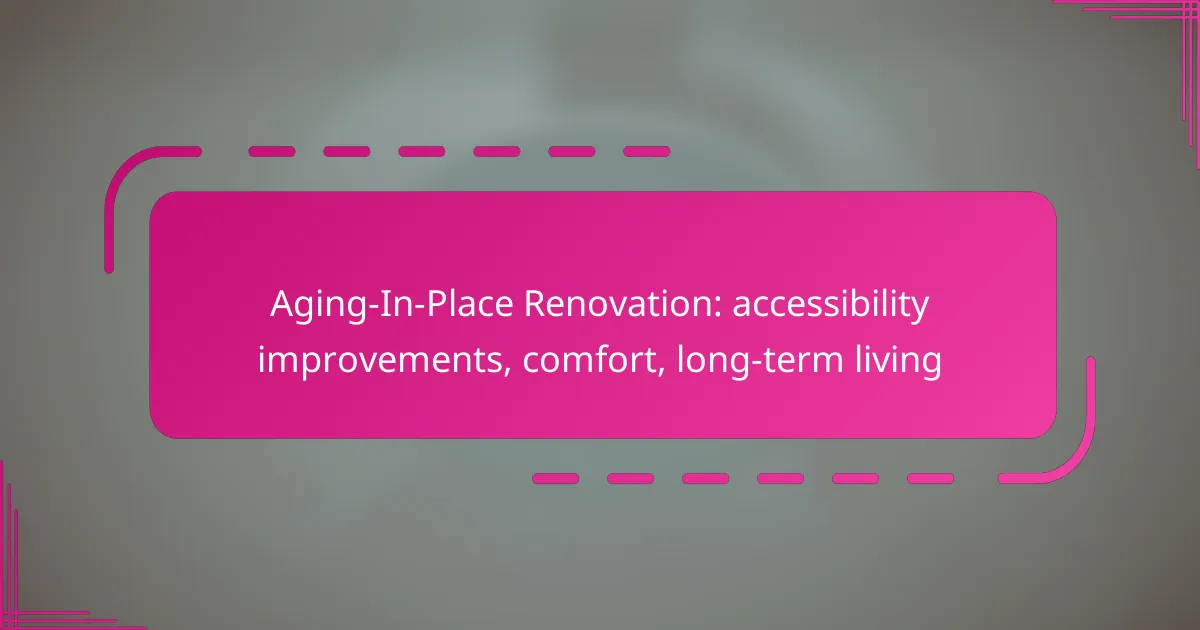Aging-in-place renovations are essential for enhancing the quality of life for seniors, focusing on accessibility, comfort, and safety within the home. By implementing key improvements such as bathroom upgrades, kitchen modifications, and smart technology integration, homeowners can create a more navigable and welcoming environment that supports long-term living. These thoughtful modifications not only reduce the risk of accidents but also foster independence and well-being for individuals with mobility challenges.

What are the best aging-in-place renovation solutions in the US?
The best aging-in-place renovation solutions in the US focus on enhancing accessibility, comfort, and safety for seniors. Key improvements include bathroom upgrades, kitchen modifications, smart technology integration, and structural adjustments to ensure ease of movement throughout the home.
Bathroom accessibility upgrades
Bathroom accessibility upgrades are essential for safe and comfortable use. Consider installing grab bars near the toilet and in the shower to provide support. A curbless shower design can eliminate trip hazards and make entry easier.
Additionally, a comfort-height toilet can aid those with mobility issues, while a shower bench allows for seated bathing. Non-slip mats can further enhance safety in wet areas.
Kitchen modifications for ease of use
Kitchen modifications should prioritize ease of access and functionality. Lowering countertops and installing pull-out shelves can make cooking and food preparation more manageable for seniors. Consider using appliances with easy-to-read controls and automatic shut-off features.
Incorporating a kitchen island can provide additional workspace and seating, while ensuring that frequently used items are within easy reach can minimize bending and stretching.
Smart home technology integration
Smart home technology can significantly enhance safety and convenience for aging individuals. Devices such as smart lighting, automated thermostats, and voice-activated assistants can simplify daily tasks and improve home management.
Consider installing security systems with remote monitoring capabilities and smart doorbells that allow for easy communication with visitors. These technologies can provide peace of mind for both seniors and their families.
Wider doorways and hallways
Wider doorways and hallways are crucial for accommodating mobility aids like walkers or wheelchairs. Ideally, doorways should be at least 32 inches wide to allow for easy passage. If renovations are underway, consider removing non-load-bearing walls to create more open space.
Ensure that hallways are clear of obstacles and provide ample room for movement, which can help prevent falls and enhance overall accessibility.
Non-slip flooring options
Choosing non-slip flooring is vital for preventing falls, a common concern for seniors. Options such as textured vinyl, cork, or rubber flooring can provide traction while being easy to maintain. Avoid slippery surfaces like polished tiles or hardwood in high-traffic areas.
When selecting flooring, consider the overall comfort and ease of cleaning, as well as the aesthetic appeal to ensure a welcoming environment.

How can accessibility improvements enhance comfort?
Accessibility improvements can significantly enhance comfort by making living spaces safer and easier to navigate for individuals with mobility challenges. These modifications not only reduce the risk of accidents but also create a more welcoming environment that supports long-term living.
Improved mobility and safety
Enhancing mobility and safety involves installing features like grab bars, ramps, and wider doorways that accommodate wheelchairs or walkers. These changes help prevent falls, which are a common concern for seniors. Simple adjustments, such as non-slip flooring and adequate lighting, can further improve safety in the home.
Consider evaluating the layout of your home to ensure clear pathways and easy access to frequently used areas. This might include rearranging furniture or removing obstacles that could impede movement.
Customization for individual needs
Customization allows homeowners to tailor their living spaces to meet specific needs, ensuring maximum comfort and usability. This can involve adjusting countertop heights, installing adjustable shelving, or incorporating smart home technology that simplifies daily tasks.
When planning renovations, engage with professionals who specialize in aging-in-place design. They can provide insights into the best solutions for your unique situation, whether that means modifying a bathroom or enhancing kitchen accessibility.
Enhanced independence for seniors
Accessibility improvements foster greater independence for seniors by enabling them to perform daily activities without assistance. Features like lever-style door handles, walk-in showers, and touchless faucets can empower individuals to maintain their routines comfortably.
Encouraging independence also involves creating an environment that supports social interaction. Open floor plans and accessible outdoor spaces can help seniors stay connected with family and friends, enhancing their overall quality of life.

What are the costs associated with aging-in-place renovations?
The costs associated with aging-in-place renovations can vary widely based on the scope of work, location, and specific modifications needed. Homeowners should expect to invest anywhere from a few thousand to tens of thousands of dollars, depending on the complexity of the renovations and local market conditions.
Average renovation costs in major cities
In major cities, the average costs for aging-in-place renovations can range significantly. For example, in New York City, homeowners might spend between $15,000 and $50,000, while in Los Angeles, costs can range from $10,000 to $40,000. Cities with lower living costs, such as Atlanta or Dallas, may see averages between $8,000 and $30,000.
These figures reflect the price of labor and materials, which can be higher in urban areas. It’s essential to obtain multiple quotes from contractors to ensure competitive pricing.
Cost breakdown by project type
Aging-in-place renovations can include various projects, each with different costs. For instance, installing grab bars and non-slip flooring may cost around $1,000 to $3,000, while a full bathroom remodel can range from $10,000 to $25,000. Kitchen modifications, such as lowering countertops or adding pull-out shelves, typically fall between $5,000 and $15,000.
Homeowners should prioritize projects based on immediate needs and long-term benefits. Simple modifications can significantly enhance safety and accessibility without breaking the bank.
Financing options for homeowners
Homeowners looking to finance aging-in-place renovations have several options. Home equity loans or lines of credit can provide funds based on the equity built in the home. Additionally, some local governments offer grants or low-interest loans specifically for accessibility improvements.
It’s advisable to research available programs and consult with financial advisors to determine the best financing strategy. Understanding the terms and potential impacts on monthly budgets is crucial before committing to any financing option.

What criteria should be considered for aging-in-place renovations?
Aging-in-place renovations should focus on enhancing accessibility, comfort, and long-term livability. Key criteria include assessing the current home layout, identifying specific accessibility needs, and evaluating future living plans.
Assessing current home layout
Begin by analyzing the existing layout of your home to determine how it accommodates mobility and daily activities. Consider factors such as room sizes, door widths, and stair accessibility. A more open floor plan can facilitate easier movement and reduce the risk of falls.
Make note of any areas that may require modification, such as narrow hallways or steps that could be replaced with ramps. Engaging a professional designer experienced in aging-in-place can provide valuable insights on effective layout changes.
Identifying specific accessibility needs
Each individual has unique accessibility requirements based on their health and mobility. Conduct an assessment to identify specific needs, such as grab bars in bathrooms, non-slip flooring, or wider doorways for wheelchair access. These modifications can significantly enhance safety and comfort.
Consider consulting with an occupational therapist who can provide tailored recommendations. Prioritize changes that will have the most immediate impact on daily living, ensuring that the home remains functional as needs evolve.
Evaluating long-term living plans
When planning renovations, think about your long-term living goals. Will you remain in your current home as you age, or are you considering a future move? This decision will influence the extent and type of renovations needed.
For those planning to stay, invest in durable materials and timeless designs that will withstand the test of time. If relocation is a possibility, focus on modifications that enhance comfort and accessibility without extensive structural changes. Regularly revisit your living plans to adapt renovations as needs change.

What are the long-term benefits of aging-in-place renovations?
Aging-in-place renovations provide significant long-term benefits, including increased comfort, safety, and independence for seniors. These improvements can also enhance property value and reduce the need for assisted living facilities.
Increased property value
Aging-in-place renovations can significantly boost the market value of a home. Features such as wider doorways, non-slip flooring, and accessible bathrooms appeal to a broader range of buyers, including families and seniors. Investing in these modifications can yield returns that often exceed the initial costs, especially in competitive real estate markets.
Consider focusing on high-impact upgrades like ramps or grab bars, which are relatively low-cost yet highly valued by potential buyers. Homes equipped for accessibility are increasingly sought after, making these renovations a smart financial decision.
Enhanced quality of life
Renovations aimed at aging in place greatly improve the quality of life for seniors. By incorporating elements like walk-in showers, lever-style door handles, and adjustable lighting, homes become safer and more comfortable. These changes reduce the risk of falls and injuries, allowing seniors to maintain their independence longer.
Additionally, creating open spaces and improving accessibility can foster a more enjoyable living environment. Simple modifications, such as installing a stairlift or adding a first-floor bedroom, can make daily activities easier and enhance overall well-being.
Reduced need for assisted living
By making aging-in-place renovations, homeowners can significantly decrease the likelihood of needing assisted living services. Features that promote independence, such as smart home technology and accessible layouts, enable seniors to live comfortably at home for longer periods. This not only preserves their autonomy but also reduces the emotional and financial burden of transitioning to a care facility.
Planning for future needs is essential; consider consulting with an aging-in-place specialist to identify key renovations that align with personal health and mobility requirements. Proactive improvements can help avoid costly and disruptive moves later on.

How do local regulations affect aging-in-place renovations?
Local regulations play a crucial role in aging-in-place renovations by dictating what modifications can be made to a home for accessibility and safety. Understanding these regulations ensures that renovations comply with building codes and zoning laws, which can vary significantly by location.
Building codes in California
In California, building codes are established to ensure safety and accessibility in residential properties. The California Building Code (CBC) includes specific provisions for accessibility that align with the Americans with Disabilities Act (ADA). These codes cover aspects such as door widths, ramp specifications, and bathroom modifications.
When planning aging-in-place renovations, homeowners should consider consulting with a licensed contractor familiar with California’s codes. This can help avoid costly mistakes and ensure that all renovations meet the necessary legal requirements. For example, doorways must typically be at least 32 inches wide to accommodate wheelchairs.
Additionally, homeowners may need to apply for permits for certain renovations, such as installing grab bars or modifying entrances. It’s advisable to check with local building departments for specific requirements and to ensure compliance with any recent updates to the codes.
